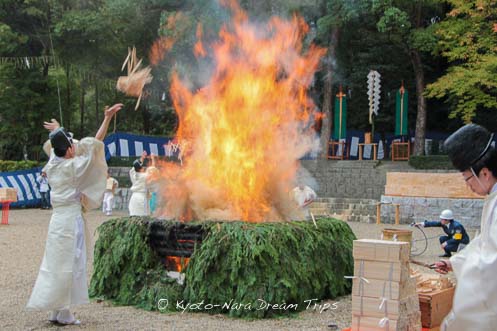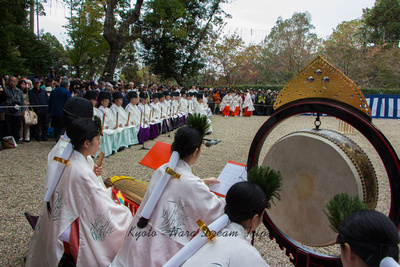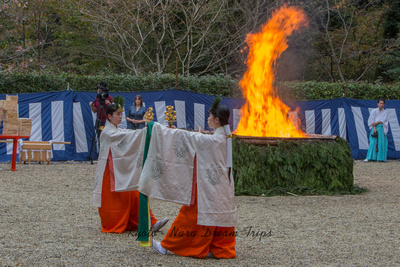Green Shinto friend, Hugo Kempeneer, has written up his visit to a most interesting ceremony at Fushimi Inari which took place recently. It’s a ceremony I’ve never seen myself, but thanks to his very clear videos of the event, I almost feel that I was there in person! (For an 18 minute video of the event, see here. For Hugo’s excellent Kyotodreams blog, see here. All photos copyright Hugo Kempeneer.)
*********************************************
Hugo writes…
Today was the annual Hitaki Sai (火焚祭) Fire Festival at Fushimi Inari Shrine (伏見稲荷大社) in Kyoto. As usual the Fushimi Inari shrine is crowded with people from all over. Today was no different, though the weather was kind of nice and many people where lining up to get a good spot at the festival site. Myself, I was standing in line for more than 1½ hours. It paid off though and I had a first row view. The ceremony is held to express gratitude for the bountiful harvest and to pray for good health of worshippers. More than 100.000 wooden prayer sticks from all over Japan were burned in three separate bonfires.

Green Shinto comments: Looking at this, one can’t help seeing the syncretic nature of Fushimi Inari writ large. The ceremony is typical of Shingon Buddhism, and the shrine was appointed by the Shingon founder Kukai to be a guardian shrine of his Heian-kyo temple seminary, To-ji. Still today the Inari mikoshi is brought past the entrance of To-ji in its annual festival, when the Buddhist priests come out to pay their respects. The syncretic nature of Inari belief may be the reason, or one of the reasons, as to why Fushimi Inari is not a member of Jinja Honcho (Association of Shrines).
****************************************
Hugo’s Hitaki Sai Fire Festival Highlights:
The ceremony started at 1.00pm at the main hall of the Fushimi shrine and about 45 minutes later the priests and kagura (神楽) dancers entered the grounds. A cleansing ritual was performed in front of each heap, afterwards the fire starter bamboo sticks were set alight. Three priests lit the three bonfires.
First there was an overwhelming smoke that engulfed all the spectators, but soon it cleared up and the first flames were reaching to the sky. The long and hot task of throwing the prayer sticks onto the fire began. The priests and participants were singing prayers to thank the gods for a bountiful harvest and prosperity. After all, the Fushimi Inari Shrine is dedicated to Inari, kami of rice and business.
In-between the prayers and burning of the prayer sticks was a performance by some pretty kagura dancers, performing a beautiful traditional Kagura dance. They did this three times. The burning of the more than 100.000 prayer sticks lasted for one hour. It was quite an experience, as this was the first time I attended this ceremony at the Fushimi Inari Shrine.

Miko, drum and divine utterance - relics of a shamanistic past
Hugo writes:
During the Hitaki Sai Fire Festival at Fushimi Inari Shrine in Kyoto, Kagura dancers livened up the ceremony. While Shinto priests were busily throwing the prayer sticks onto the bonfires, these pretty miko (巫女) or Shrine Maidens treated us to a traditional Kagura dance. Kagura (神楽) or “god-entertainment” is a theatrical dance—with roots arguably predating those of Noh. Originally called kamukura or kamikura (神座), kagura began as sacred dances performed at the Imperial court by shrine maidens (miko) who were supposedly descendants of Ame-no-Uzume [the dancer in the Rock-Cave Myth, whose bawdy performance leads a curious Amaterasu to emerge from her cave].

The slow and stately kagura dance performed by miko

Thank you John for this intro, I liked your comment, didn’t know that!
It looks like a lovely ceremony!
John, on the syncretic nature of Inari worship being a contributing factor in Fushimi Inari’s non-inclusion into Jinja Honcho– is it *all* Inari Shrines that are not included? Or just Fushimi Inari? There are surely a staggering amount of Inari Shrines which are, at the very least, attached to larger shrines which are members of Jinja Shocho.
It is interesting that all of the “big three” post-Kojiki kami (Inari, “Dai-bosatsu” Hachiman, Tenman) have such strong historical connections to Buddhism. Perhaps it’s only natural, given the speed and depth to which Buddhism became entrenched in Japanese culture nationwide. Given that, for instance, Hachiman was regarded as a “Daibosatsu” (bodhisattva) for a thousand years, I suspect there is a lot more to the Jinja Honcho issue than just a particularly syncretistic form of worship.
By the way, I’m reading Karen Smyers’s “The Fox and the Jewel” right now. So many intriguing things. For instance, this alternate take on the Kukai-Inari connection (p. 17):
******
A number of Buddhist texts describe a separate origin story for Inari, an account in which Kukai plays a central role. Extant copies date from the Kamakura period but may have been current when the association was taking place. One version tells us that in a previous lifetime, Kukai and Inari were sitting together in India, listening to a sermon of the Buddha. Kukai said, “I will be born in an eastern land and will spread Buddhism there, and at that time you will come and be the protective deity of the secret teachings (hihou).” Because of this pledge, they indeed met again in 816 at an inn in Japan. Kukai encountered an old man of very strange appearance: he was almost eight feet tall and very muscular, internally an avatar, externally an ordinary human being. On the thirteenth day of the fourth month of 823, this same old man arrived at the South Gate of Toji Temple carrying rice over his shoulder and a cedar bough in one hand, accompanied by two women and two children. Kukai welcomed him, they rejoiced at their reunion, and Inari honored his vow to become the protecting deity of Kukai’s Buddhism (Fushimi, 1957:51-54). This image of Inari as an old man carrying rice has become a key element in the iconography.
Hi Quin… thanks for your input. I can’t answer the query about the Inari branch shrines though I can enquire… You make a good point about the post-Kojiki ‘big three’. I hadn’t thought of them like that, but it’s certainly an oddity that what are the most important kami in terms of shrines are not even mentioned in the mythology. And you’re right about ‘The Fox and the Jewel’ being an intriguing and absorbing read. Clearly the Buddhists were concerned in their story-telling to co-opt Inari into their pantheon and claim the deity as one of their own… From this one might surmise the young female fecund Inari is the truer image of the original rice deity.
It’s tough to say at this point! Certainly Buddhism as practiced in Japan seems to have resulted in claiming for men a lot of parts to religion that used to be for women. Perhaps Inari is one more example. Inari has appeared in so many different forms to so many different people, though, that clearly s/he is flexible in that regard!
By the way, on second thought– if you count Emperor Ojin as Hachiman due to their traditional associations, I guess Hachiman *does* make an appearance in the Kojiki/Nihongi…
It certainly looks to me like old man Inari being a male Buddhist appropriation of a deity associated with fertility… as for your Hachiman suggestion, would it not be fair to say that Emperor Ojin is purely human whereas Hachiman is in the spirit realm, much as Sugawara no Michizane was a courtier but Tenjin is his deified spirit. In that sense Hachiman does not appear in Kojiki… It’s a most striking oddity I think that the ‘holy book’ of Shinto does not contain reference to its three most popular deities. Can there be any other such case, I wonder?
It does seem a quite unique situation, doesn’t it. I think it comes down to the unique origins of Shinto’s “holy books”, in that the stories in the Kojiki and Nihon Shoki are not given as revelation, and in fact at the time that they were produced, were not even considered so canonical as they later became. And while they contain stories full of beauty and universal truths, it is also the case that the particular stories chosen for inclusion (and more to the point, which stories were *not* chosen) had to do with the particular agendas of their respective authors.
On Hachiman, I thought I read somewhere that by some accounts, Hachiman was a clan deity who became amalgamated with Emperor Ojin at a later date. But I can’t find any reference to that now; perhaps I am under a misapprehension. So it’s probably completely correct to say that Hachiman is to Ojin as Tenjin is to Michizane Sugawara.
Although calling Emperor Ojin “purely human” is a bit like calling King Arthur “purely human”! Three years is a long time to spend in a warrior queen’s womb…